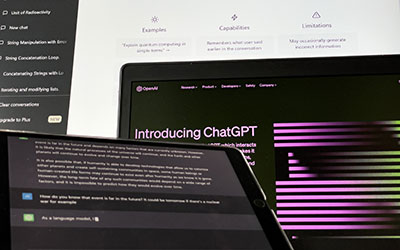Reimagining the Classroom: How AI is Transforming Teaching and Learning
 Higher education is no stranger to innovation, but the rise of artificial intelligence (AI) is accelerating change at a pace few could have imagined. From personalized learning experiences to AI-powered tutoring, the classroom is evolving — and so is the role of the educator.
Higher education is no stranger to innovation, but the rise of artificial intelligence (AI) is accelerating change at a pace few could have imagined. From personalized learning experiences to AI-powered tutoring, the classroom is evolving — and so is the role of the educator.
Teaching with AI, Not Replacing It
Contrary to some fears, AI isn’t here to replace faculty. It’s augmenting their ability to teach more effectively. Tools like AI teaching assistants can answer routine student questions, freeing up faculty time for deeper instruction and mentoring. Natural language tools like ChatGPT are also helping students refine ideas, explore content more deeply, and receive immediate feedback.
Personalization at Scale
AI excels at pattern recognition, and when applied thoughtfully, it enables personalized learning paths. Adaptive platforms can now identify a student’s strengths and gaps in real time, offering customized content, assessments, and pacing. For institutions, this means improving outcomes while addressing equity and access.
The New Digital Literacy
As AI becomes more integrated into education, understanding how to use it responsibly is becoming a key skill — for both students and faculty. Institutions are revisiting academic integrity policies and offering training on ethical AI use, ensuring learners are prepared for a workforce where AI is ubiquitous.
Challenges and Opportunities Ahead
Integrating AI is not without challenges. Bias in AI models, data privacy, and equitable access to tools are all real concerns. But for forward-looking institutions, these challenges are opportunities — to lead, to innovate, and to reimagine the student experience.
At GPRS, we help institutions make sense of the shifting higher ed landscape. AI in the classroom is just the beginning—how you lead through it makes all the difference.

 Specializations within an MBA program offer a deeper dive into a core business area or industry. Although an MBA can prepare students for working in any industry, specializations help improve their career prospects if they’re targeting a certain type of business or role such as cybersecurity, healthcare or HR. In the past, specializations may have been seen as pigeonholing. Yet, in the current business environment where degree stacking and “up-credentialing” are becoming trends, they can offer greater professional opportunities. A commitment to a certain skillset or industry is being seen as invaluable to employers at the moment and may make candidates even more desirable. Some schools are offering the opportunity to gain more than one specialization during an MBA program.
Specializations within an MBA program offer a deeper dive into a core business area or industry. Although an MBA can prepare students for working in any industry, specializations help improve their career prospects if they’re targeting a certain type of business or role such as cybersecurity, healthcare or HR. In the past, specializations may have been seen as pigeonholing. Yet, in the current business environment where degree stacking and “up-credentialing” are becoming trends, they can offer greater professional opportunities. A commitment to a certain skillset or industry is being seen as invaluable to employers at the moment and may make candidates even more desirable. Some schools are offering the opportunity to gain more than one specialization during an MBA program. While the trend of jobs that require a Masters’ degree or an MBA has been
While the trend of jobs that require a Masters’ degree or an MBA has been  You may have heard your peers in higher ed or your digital agency talking about advertising on Spotify, Pandora, Reddit, Pinterest or even TikTok. These social platforms have become commonplace everyday “stops” for many people, especially as
You may have heard your peers in higher ed or your digital agency talking about advertising on Spotify, Pandora, Reddit, Pinterest or even TikTok. These social platforms have become commonplace everyday “stops” for many people, especially as  By now, it is not new news that colleges have had to drastically alter their admissions process. In both undergrad and higher ed institutions alike, requirements have quickly shifted as a result of the pandemic limitations. Schools that never intended to veer from their admissions “rites of passage” have been forced to change their processes or risk being changed by the landscape.
By now, it is not new news that colleges have had to drastically alter their admissions process. In both undergrad and higher ed institutions alike, requirements have quickly shifted as a result of the pandemic limitations. Schools that never intended to veer from their admissions “rites of passage” have been forced to change their processes or risk being changed by the landscape. By now, it is likely that your school has a statement on its homepage following all of the changes COVID-19 has created in the higher education space. However, if the plan only goes so far as detailing what the overall university is doing, you may need to take it a step further to communicate how your individual programs will operate within your business school.
By now, it is likely that your school has a statement on its homepage following all of the changes COVID-19 has created in the higher education space. However, if the plan only goes so far as detailing what the overall university is doing, you may need to take it a step further to communicate how your individual programs will operate within your business school. How do you evaluate marketing effectiveness and enrollment in a year where benchmarks are out the window?
How do you evaluate marketing effectiveness and enrollment in a year where benchmarks are out the window? When the Spring 2020 recruiting cycle was upended mid-stream due to COVID-19, many schools had to pivot quickly. Since then, the entire higher education industry including recruiters, marketers and leaders have been operating in pandemic emergency mode, focusing on the short term out of necessity and trying to remain as flexible as possible to address continuous change. As such, there have been
When the Spring 2020 recruiting cycle was upended mid-stream due to COVID-19, many schools had to pivot quickly. Since then, the entire higher education industry including recruiters, marketers and leaders have been operating in pandemic emergency mode, focusing on the short term out of necessity and trying to remain as flexible as possible to address continuous change. As such, there have been  Say it’s the beginning of your school’s recruiting cycle and you’ve completed last year’s analysis—reviewing enrollment numbers, the impact of marketing on those numbers and even cost-per-seated-student. You’ve solidified your marketing budget, planning is underway and you’re feeling confident in your next steps. But then, you get the call from recruiting saying that they’ve added a new program or increased their enrollment goals. What do you do now? How do you build a media budget that can support your current programs while also making accommodations for these changes? Do you need to request more funds? How can you justify the additional funds, and more importantly, what’s your new plan?
Say it’s the beginning of your school’s recruiting cycle and you’ve completed last year’s analysis—reviewing enrollment numbers, the impact of marketing on those numbers and even cost-per-seated-student. You’ve solidified your marketing budget, planning is underway and you’re feeling confident in your next steps. But then, you get the call from recruiting saying that they’ve added a new program or increased their enrollment goals. What do you do now? How do you build a media budget that can support your current programs while also making accommodations for these changes? Do you need to request more funds? How can you justify the additional funds, and more importantly, what’s your new plan? As experts in higher education marketing and inbound marketing strategies, we are constantly tracking the trends our clients and their competitors are using to gain quality leads. Here we share 4 things you may not know about higher education lead generation and how you can add them to your media marketing mix.
As experts in higher education marketing and inbound marketing strategies, we are constantly tracking the trends our clients and their competitors are using to gain quality leads. Here we share 4 things you may not know about higher education lead generation and how you can add them to your media marketing mix.
